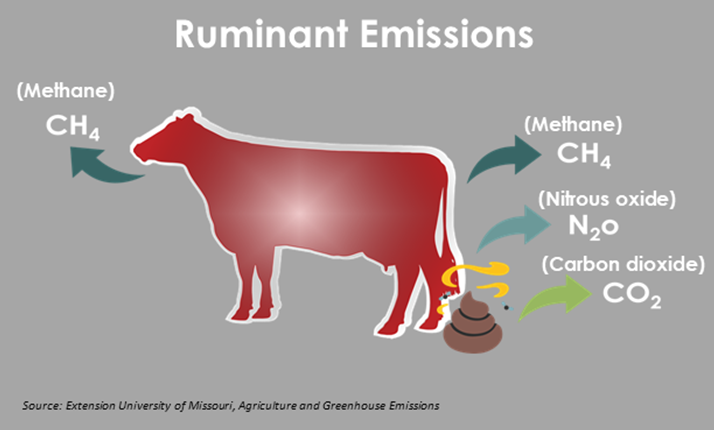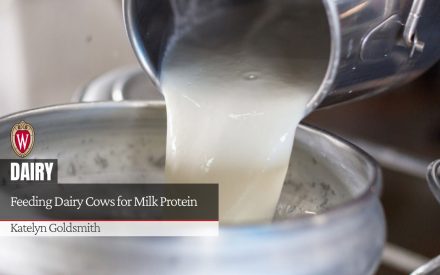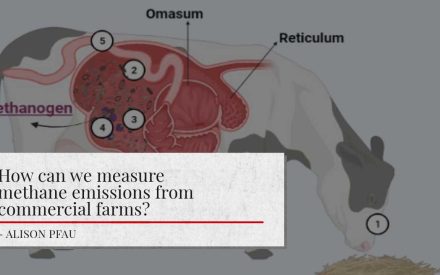A greenhouse gas is any gas in the atmosphere capable of absorbing heat from the sun and stopping it from radiating back into space. Many greenhouse gases occur naturally in our environment at low concentrations. However, human activity is increasing the concentration of greenhouse gases in our atmosphere, thereby trapping, and storing, additional heat and increasing overall global average temperatures. Therefore, reducing greenhouse gas emissions from all sectors of society, including agriculture, is a concern for all.
Major greenhouse gases include water vapor (H2O), ozone (O3), carbon dioxide (CO2), methane (CH4), nitrous oxide (N2O), and various industrial fluorinated gases. While carbon dioxide is the most discussed greenhouse gas, methane and nitrous oxide have 25 and 298 times the impact on heat absorption as an equal amount of carbon dioxide, respectively.
Agricultural activities, including crop and soil management, raising of ruminant livestock (enteric fermentation), and livestock manure management, impact the production of greenhouse gases, particularly methane and nitrous oxide. It is estimated the agriculture industry contributes 10% to all greenhouse gas emissions, behind transportation (29%), electric power (25%), and commercial (23%) industries
Nitrous oxide production from cattle
Manure and commercial fertilizers are the primary contributors to agricultural nitrous oxide emissions. The generation of nitrous oxide from manure is impacted by the animal’s ration, particularly the diet’s protein content, as well as manure storage and handling.
Cattle can excrete 75 to 95% of their protein intake as urinary nitrogen. Under anaerobic conditions, this nitrogen can volatilize to the atmosphere as nitrous oxide, such as in manure storage systems or when applied to saturated or soon-to-be saturated soils.
To reduce urinary nitrogen concentrations, cattle rations should meet, but not exceed, the recommended protein requirements for the animal’s life stage and/or lactation status. Cattle can also be fed using a higher
energy–protein forage ratio or by balancing high protein diets with high-energy supplements.
Enteric methane production by ruminants

Ninety-six percent of the methane produced by livestock comes from cattle and is released into the atmosphere when the animal belches/burps. Methane production in the cow’s rumen is part of the natural enteric fermentation process carried out by rumen microbes. The microbes produce hydrogen gas, carbon dioxide, and methane during the fermentation process and these gases are expelled by the animal. Enteric fermentation is responsible for approximately a quarter of greenhouse gas emissions from the agriculture sector.
The most effective strategy to reduce enteric methane production is through the alteration of the animal’s diet.
- Feeding high-quality, highly digestible forages or grains enhances the volatile fatty acid, propionate, in the rumen. An increase in propionate production causes a “hydrogen sink” effect, where hydrogen ions are tied up in the propionate molecules, reducing the amount of hydrogen available for methane production.
- Grinding and pelleting forages increase their rate of passage and reduce the number of times the feedstuffs are in the rumen for digestion and fermentation. With reduced time in the rumen, there is less opportunity for methane production.
Feed additives have the potential to reduce enteric methane emissions. Additional research is needed to determine their long-term effects on animal health and production, particularly in dairy. In fact, some products currently being used to reduce methane are considered
anti-nutritional factors.
Feed additives can be used to either inhibit the formation of methane in the rumen or to protect proteins from decomposition by less-desirable rumen microbes, thus reducing the production of methane.
- Examples of methane inhibitors include—
- 3-nitrooxypropanol (3NOP), which suppresses the enzyme triggering rumen methane production.
- bromoform (red seaweed), which interrupts enzymatic processes that produce methane.
- nitrates which optimize rumen fermentation by changing the pathway from methane to ammonia production.
- Examples of rumen modifiers include—
- ionophores, tannins, and essential oils.
- Other approaches include—
- removing protozoa and other
- methane-producing microbes (methanogens) from the rumen.
- encouraging acetogenic bacteria to reduce the amount of available acetate and methane production.
- vaccinating cows to stimulate antibodies against the methanogens.
Before implementing a dietary or management change to reduce potential methane production by cattle, farms should consider these factors: impact to beneficial rumen microbes, toxicity to the animal, adaptation potential of rumen microbial population, impact on milk production and/or animal health, cost of product and return on investment, availability of a product, and method of delivery to the animal.
Carbon cycling in agricultural systems
Agricultural systems have the capacity to sequester carbon-based greenhouse gases in plants and soils, thereby reducing the impact of the industry’s carbon dioxide and methane gas emissions.
The biogenic carbon cycle is responsible for the movement of carbon through the natural environment. Cattle start the cycle by releasing carbon dioxide through respiration and methane through enteric fermentation into the atmosphere. Over 10 to 12 years, atmospheric methane is degraded into carbon dioxide through the process of hydroxyl oxidation.

Atmospheric carbon dioxide is used by plants during the process of photosynthesis to create glucose to build and fuel their own cells. The carbon, once locked up in plant tissues, can be used as feedstuffs for animals or microbes,
starting the biogenic carbon cycle over again.
However, some of the plant tissues, particularly root materials, will be decomposed within the soil by microbes and stored as soil organic matter. The addition of manures to soil can also contribute to soil organic matter. The long-term storage of carbon in the soil as stable organic matter (humus) is referred to as carbon sequestration and directly reduces greenhouse gas concentrations in the atmosphere.
Carbon stored in the soil may stay in the soil for a few years to thousands of years, depending upon land management practices. It is believed soil carbon sequestration may be able to offset up to 10% of human-induced greenhouse gas emissions.
Carbon sequestration in agricultural soils can be enhanced by reducing or eliminating tillage, planting permanent vegetation (such as pastures), altering crop rotations to include
overwintering cash crops or cover crops, utilizing managed grazing, and adding manure or composts to the soil.
Practices that increase carbon sequestration also potentially increase soil health, soil water dynamics, and nutrient cycling, which can further reduce agricultural greenhouse gas emissions through reduced methane and nitrous oxide emissions when manures are applied to soils.
Summary
Agricultural production systems result in the generation of several greenhouse gases, including methane, nitrous oxide, and carbon dioxide. Enteric fermentation and manure management contribute over 40% of the total greenhouse gases generated by the agriculture industry.
Significant long-term research on management strategies, particularly the inclusion of feed additives, to reduce greenhouse gas emissions from cattle without sacrificing milk production and dairy product integrity, animal health and well-being, and farm profitability are needed before large-scale adoption. However, immediate efforts to improve rumen efficiency and performance by improving feed efficiency will result in additional nutrients directed to the production of milk and meat and fewer nutrients being lost to the atmosphere as greenhouse gases.
Download Article

 Feeding Dairy Cows for Milk Protein
Feeding Dairy Cows for Milk Protein ▶️ Watch: Nutritional Strategies to Reduce Methane Emissions in Lactating Cows
▶️ Watch: Nutritional Strategies to Reduce Methane Emissions in Lactating Cows How can we measure methane emissions from commercial farms?
How can we measure methane emissions from commercial farms? ▶️ Watch: Detectando fallas temprano en sistemas de ordeño
▶️ Watch: Detectando fallas temprano en sistemas de ordeño


